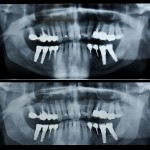
Dental implants are now widely used and there is now good information on clinical survival rates. However whether sex has any impact on clinical outcomes is unknown. The aim of this review was to assess if there were any differences in marginal bone loss (MBL) and post-operative infection for implants inserted in male or female patients
Methods
Searches were conducted in PubMed/Medline, Web of Science and the Cochrane Oral Health Group Trials Register. These were supplemented by a manual search of a number of journals. Clinical human studies, either randomized or not, involving a minimum of 10 patients comparing implant failure, post-operative infection and/or MBL in men versus women with a minimum follow up period of 1 year were considered. Three reviews independently selected studies with the Newcastle-Ottawa scale (NOS) being used to assess study quality.
Results
- 91 studies consisting of 4 RCTs, 7 CCTs, 14 prospective and 66 retrospectives studies were included.
- 62 studies were considered to be of high quality.
| No. of implants | No. of failures ( %) | |
| Males | 27, 203 | 1185 (4.36%), |
| Females | 25,154 | 1039 (4.13%) |
- The risk of implant failure in males was higher; RR = 1.21 (95% CI; 1.07 to 1.37) (P = 0.002).
- The insertion of dental implants in men statistically affected the MBL with the mean difference (MD) = – 0.20, (95% CI; -0.36 to -0.04) P = 0.02
Conclusions
The authors concluded: –
The present study suggests that the insertion of dental implants in men affects the implant failure rates in comparison with women. Due to the limited number of studies reporting results on MBL, it is difficult to estimate the real effect of sex on the marginal bone level. The results of the present review should be interpreted with caution due to the presence of uncontrolled confounding factors in the included studies.
Comments
This systematic review has chosen to include studies of a wide range of designs. The majority of the studies are retrospective in nature and these designs are inherently at greater risk of bias and this does need to be taken into consideration when assessing their findings. The proportions of failures in males and failure were broadly similar at just over 4% but although the meta-analysis does suggest that a 21% increased risk in males the confidence intervals are broad indicating that the risk could lie between 7-37% . There authors also highlight a lack of information in some of the studies in particular in relation to potential confounders. While the authors also suggest some potential reasons as to why a difference might exist between males and females eg. higher bite forces in males and also higher smoking rates. The likelihood is that if a suitable number of high quality RCTs were available and most of the potential confounders were accounted for, then there would be no difference between the sexes.
Links
Chrcanovic BR, Albrektsson T, Wennerberg A. Dental implants inserted in male versus female patients: a systematic review and meta-analysis. J Oral Rehabil. 2015 May 18. doi: 10.1111/joor.12308. [Epub ahead of print] PubMed PMID: 25989467.
Dental Elf -13th May 2015 – Dental implants: smokers have poorer outcomes suggests review
Dental Elf -1st May 2015 – Dental implants: platform switching may decrease bone loss

Review suggests higher dental implant failures in males http://t.co/azOE9zjIlT
Dear Mr. Richards,
Thank you for the interest in our article. I have one remark to make concerning your comments. As mentioned in the manuscript, the 4 RCTs included in the study were not randomized for sex, but for other variables. There is no possibility to randomize the patients receiving dental implants when it comes to sex. The patients are either men or women. Thus, your statement ‘The likelihood is that if a suitable number of high quality RCTs were available (…)’ needs some attention. Thank you.
Best regards,
Bruno
While one would not randomise based on sex. It would be possible to stratify the sample based on sex particularly when using larger samples.
Lower dental implant failure rates in females? http://t.co/azOE9zjIlT
Risk of dental implant failure higher in males? http://t.co/azOE9zjIlT
Review suggests lower dental implant failure rates in females? http://t.co/azOE9zjIlT
Don’t miss – Dental implant- failure rates higher in males? http://t.co/azOE9zjIlT
#Dental implants: failure rates higher in males? http://t.co/WDRFZq1Vec http://t.co/1fShcaOc8d